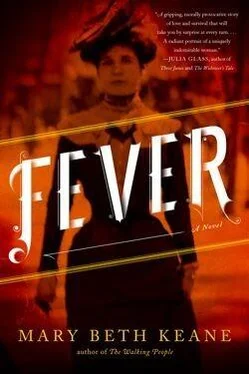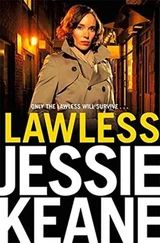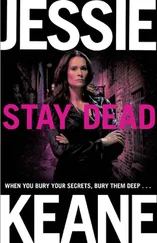The woman is rumored to be of fair complexion with a buxom figure and rosy cheeks. Whether she understands the charges piled against her is a matter of concern for the DOH. “We’re talking about brand-new science,” a senior health inspector explained. “If what Dr. Soper posits is true, then she is the first healthy carrier of Typhoid Fever discovered in North America.”
The butler of the family who was the cook’s most recent employer, and who gave his name only as “Francis,” claims that the daughter’s illness and death is nothing more than a tragic coincidence. He tells us that his own wife died of the illness several years back, and so have others he’s known who never had any contact with the accused cook. He claims further that the cook was healthy and showed absolutely no sign of illness. “They took her like they would a common criminal,” he said, showing visible signs of distress. “And for what? I don’t believe what they’ve said about her.” A female eyewitness to the cook’s capture stated that “she fought with the strength of ten men, but they overpowered her.”
This incredulity, authorities say, is a matter of education, and further denials from the woman may lead to her permanent quarantine. A nurse at Willard Parker, who asked that her name be withheld, says the accused woman at the center of this case is the picture of fury. She refuses meals, declines company, and walks back and forth like a caged animal. When asked if she believes what’s been alleged about the woman, the nurse replied, “I myself don’t understand it, but I think the woman should try to listen to them. She’s not helping herself the way she is now.”
Several leading doctors believe Typhoid bacilli are manufactured in the gallbladder, and a representative from the Department of Health states that if the accused woman does not submit to surgical removal of her gallbladder within the month, she will be transferred to North Brother Island in the East River, where she will remain segregated from society for an indefinite length of time.
When asked for his opinion of the case, Mr. Robert Abbott, a criminal attorney who practices in New York City, says that her situation strikes him as somewhat similar to that of Niall E. Joseph, whom Boston authorities have isolated upon suspicion of being a leper.
Mary wasn’t arrested right away. There were warnings. Requests. It all started with an air of courtesy, as if Dr. Soper believed that if he simply notified her of the danger lurking inside her body she would excuse herself from society. And after, when he and his colleagues resorted to far-less-polite means, they said it was her fault for raising a knife instead of listening, for not doing as she was told.
On a cold morning in March 1907, the Department of Health coordinated with the New York City Police Department and decided that Mary Mallon must be brought in. Dr. Soper suggested she might surrender more easily to a woman and sent a doctor named Josephine Baker to ring the bell of the Bowen residence, where Mary was employed, with four police officers standing behind her. They had not considered that even in the face of such authority her friends would lie for her, help hide her, insist that she could not be the person they were seeking. When they finally found her, she would not come peacefully, so each officer gripped her by a limb and carried her across the snow-covered yard while the rest of the domestic staff looked on. Once the police got her into their truck she started swinging and kicking, until finally they wedged her between their stout bodies and held her as well as they could, and Dr. Baker sat on her lap. “Please, Miss Mallon,” Dr. Baker said, over and over, and after a while, “Please, Mary.”
Mary assumed they were bringing her to the police station on East Sixty-Seventh, so when the truck continued downtown in a southeasterly direction along the same route she took from the Bowens’ to the rooms she shared with Alfred on East Thirty-Third, she thought for a hopeful moment that they might be dropping her at home. They had come to teach her a lesson, she prayed, and now they would set her free. She glimpsed street signs through the small barred window as the driver turned east at Forty-Second Street. They traveled south along Third Avenue until Sixteenth Street, and then east again with such urgency that she could feel the rhythm of the horses’ sleek heads pumping. The truck stopped just before the river, at the main entrance of a building Mary didn’t recognize, at the very end of a block so desolate that she felt the first stirring of panic that no one she knew would ever find her there.
Dr. Soper was waiting at the entrance to the Willard Parker Hospital, but instead of speaking to her, he just nodded to the pair of policemen who had her braced by her elbows. Up on the sixth floor, they hurried her along the corridor to the Typhoid Wing, where more doctors were waiting in a room with a gleaming mahogany table. One of her guards indicated where she should sit, and before she could properly look around the room, Dr. Soper told her and the rest of the people present that the newest theory of disease had to do with germs and bacteria, and although Mary appeared perfectly healthy, he had good reason to believe that she was, at that very moment, manufacturing Typhoid bacilli inside her body and passing along the disease to innocent victims. He accused her of making twenty-three people sick and being the cause of at least three deaths. “Those are the cases we know of,” he said. “Who knows how many more we’ll find when we can investigate Miss Mallon’s full employment history?” In front of five other men and Dr. Baker, Dr. Soper turned to her, finally, the source of all this trouble, as if waiting for her to say something. Mary felt like her mind had dropped straight out of her head like a stone.
“George,” Dr. Baker said, “she hasn’t even been here fifteen minutes. Perhaps we could give her time to collect herself.”
“Back here in half an hour, then?” one of the other doctors asked.
“In the morning, gentlemen,” said Dr. Baker. “There is nothing that can’t wait until morning, is there?”
No, Mary thought, this mistake will be corrected by morning and I’ll be gone. I’ll walk straight home, make a pot of coffee, tell the whole story to Alfred, and never come near the Willard Parker Hospital again.
Dr. Soper tilted his head and considered Mary from across the table. “Tomorrow,” he agreed. “Fine.”
• • •
Mary’s bed was at the end of a row, in a large room that held sixteen beds, all occupied except for hers, which waited with the sheets tucked tight and the small, flat pillow placed exactly at the center of the head. Guards stood outside the entrance of the room, positioned so they could see her through the narrow pane of glass on the door. A nurse had left her alone for a moment shortly after showing her to her room, and she’d simply opened the door and walked toward the stairs, but an officer shouted at her to stop, and a passing doctor blocked her way. “I was told I could get word to someone,” she said to the officer as he marched her back. “When?” But he only shrugged, rocking back and forth from heel to toe as he eyed her, and she felt a twitch go through her body as she measured the distance to the end of the corridor.
That first night at Willard Parker, when a nurse came in to turn off the lamps, Mary lay on her cot and pressed her hands against her ears. It was a misunderstanding, surely. Everything would be sorted out in a matter of days. Alfred wouldn’t expect her home until Saturday and would have no way of knowing what had happened. Even then, he might not worry, believing she’d been asked by the Bowens to stay on through the weekend. She had only the money in her pocket and the clothes on her back. Dr. Baker had said she’d be allowed a telephone call, but who would she call? There was no telephone in the rooms she shared with Alfred. No one in their building had a telephone. She certainly couldn’t call the Bowens.
Читать дальше












